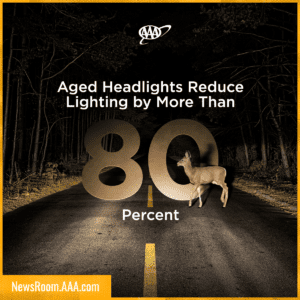BOISE – With Halloween and the switch to Daylight Savings Time both taking place this weekend, AAA and the Idaho Transportation Department remind drivers to do their part to prevent a scary situation on the road.
Halloween is one of the deadliest days of the year – children are twice as likely to be killed by a car on Halloween night as on any other night of the year. And with the change to Daylight Savings, more pedestrians and bicyclists will be on the road during the dark hours in the late afternoon.
“The decision to participate in trick-or-treating and Halloween parties is a very personal one this year. AAA urges families to follow all health and safety guidelines in their area, but those who choose to be out and about need to do so as safely as possible,” says AAA Idaho spokesman Matthew Conde. “Many of the things that will keep people safe on Halloween night are applicable to nighttime driving throughout the year.”
According to research by the AAA Foundation for Traffic Safety, 96 percent of drivers view drowsy driving as very or extremely dangerous, but 24 percent admitted to driving when they were so tired that they had a hard time keeping their eyes open at least once in the 30 days before the survey. Additional AAA research finds that drivers who have slept less than five hours have a crash risk comparable to someone who is driving drunk.
ITD reports that in 2019, drowsy driving was a contributing factor in 1,350 Idaho crashes. But due to the difficulty of proving drowsy driving after the fact, the actual number could be much higher.
“Any time a driver gets behind the wheel, we ask them to be engaged drivers,” said ITD Highway Safety Manager John Tomlinson. “This means giving your full attention to the road and the other people on it. When you are fatigued, it makes it much more difficult to respond to the challenges of the roadway.”
AAA and the Idaho Transportation Department are launching a new safety campaign to reduce the number of drowsy driving injuries and fatalities in the Gem State. “If you snooze, we all lose” is a reminder to motorists that nodding off behind the wheel puts everyone at risk. Drivers should get plenty of sleep before they hit the road, or delegate the task to a more-rested driver.
“Just like drunk driving, it takes courage to say that you’re too tired to safely operate a motor vehicle,” Conde said. “But it’s the right thing to do, and you’ll feel good about your decision.”
Over time, heat and sunlight can cause headlight lenses to take on a yellowed, cloudy appearance that AAA testing shows can block up to 80 percent of the available light. Vehicle owners can use an inexpensive kit from a local auto parts store to polish the lenses in about an hour, or contact a trusted repair or auto body shop to have the work done for them.

HALLOWEEN TIPS
- Mix it up. Instead of trick-or-treating, consider buying candy for your family and then taking a walk around the neighborhood to complete a scavenger hunt that maintains distancing.
- Have a plan. If you decide to participate in trick-or-treating, have a plan for where your children will go and when they’ll be back. Costumes should allow kids to see, be seen, and move quickly. Instruct children to never enter a home or garage to retrieve candy.
- Use masks properly. Use a face covering to prevent the spread of illness as part of your costume. A safety mask under a costume mask could make it difficult to breathe.
NIGHTTIME SAFETY ADVICE FOR PEDESTRIANS, CYCLISTS AND DRIVERS
- Don’t cut corners. Many crashes involving pedestrians happen in the middle of the block.
- Ditch the distractions. Pedestrians, cyclists and drivers need to stay alert and scan the road.
- Drive slowly. AAA says that a pedestrian who is hit by a car traveling at 30 mph is twice as likely to be killed when compared to a car traveling at 25 mph.
- Stay sober. Every year, impaired drivers and pedestrians are injured or killed in a collision.
- Be careful backing up. Your car could have a rear blind zone. Don’t rely on back-up cameras alone – if you’re not sure, check around the vehicle before backing up.

